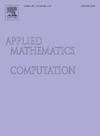三维各向异性材料中Hausdorff导数热传导方程的基于Hausdorff分形距离的时空径向基函数配置方法
IF 3.4
2区 数学
Q1 MATHEMATICS, APPLIED
引用次数: 0
摘要
本文提出了基于Hausdorff分形距离的时空径向基函数(RBF)配置方法,并将其用于模拟Hausdorff导数热传导方程下各向异性材料的瞬态传热问题。将Hausdorff分形距离引入到传统rbf中,在此基础上,建立了一种考虑材料导热系数各向异性和时空分形特征的无网格方法来求解Hausdorff导数导热问题。为了进一步提高配点法的精度,我们将配点法的源点设置在空间计算域之外,而不是分布在原域内。数值实验结果表明,该方法与有限元法和传统的RBF配置法相比,具有优越的性能,可作为模拟复杂几何条件下Hausdorff导数瞬态热传导问题的有力工具。本文章由计算机程序翻译,如有差异,请以英文原文为准。
A spatio-temporal radial basis function collocation method based on Hausdorff fractal distance for Hausdorff derivative heat conduction equations in three-dimensional anisotropic materials
In this paper, the spatio-temporal radial basis function (RBF) collocation method based on Hausdorff fractal distance is developed and used to simulate the transient heat transfer problems in anisotropic materials governed by Hausdorff derivative heat conduction equations. We introduce Hausdorff fractal distance into the conventional RBFs, and based on this incorporation, establish a meshless method to address Hausdorff derivative heat conduction problems, in which the anisotropy of the thermal conductivity of the material and spatio-temporal fractal characteristics are taken into account. We set the source points of the collocation method outside the spatial computational domain instead of distributing them within the original domain to further improve the accuracy of the method. Numerical experiments carried out in this study demonstrate the superior performance of the proposed approach compared to the finite element method and traditional RBF collocation method, showing that the developed method can be considered as a competitive tool for simulating Hausdorff derivative transient heat conduction problems in complex geometries.
求助全文
通过发布文献求助,成功后即可免费获取论文全文。
去求助
来源期刊
CiteScore
7.90
自引率
10.00%
发文量
755
审稿时长
36 days
期刊介绍:
Applied Mathematics and Computation addresses work at the interface between applied mathematics, numerical computation, and applications of systems – oriented ideas to the physical, biological, social, and behavioral sciences, and emphasizes papers of a computational nature focusing on new algorithms, their analysis and numerical results.
In addition to presenting research papers, Applied Mathematics and Computation publishes review articles and single–topics issues.

 求助内容:
求助内容: 应助结果提醒方式:
应助结果提醒方式:


